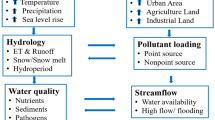Abstract
The ability of a wet swale, constructed in an area of poor soil permeability, to manage runoff from a roadway was monitored through 27 storm events over a period of 8 months. During the monitoring period, the wet swale reduced the total runoff volume by 50.4% through exfiltration and evapotranspiration. The wet swale significantly decreased the influent pollutant concentrations, and the effluent mean concentrations of total suspended solids, total phosphorus, chemical oxygen demand, ammonium, oxidized nitrogen, and total nitrogen in the effluent were 31 mg/L, 0.10 mg/L, 29 mg/L, 0.52 mg/L, 0.35 mg/L and 1.28 mg/L, respectively. Pollutant loads were also substantially reduced from 70% to 85%. Plant uptake played an important role in nutrient removal in the wet swale. Approximately half of the nitrogen (53.8%) and phosphorus (51.5%) that entered the wet swale was incorporated in above-ground plants. It is shown that wet swales are useful for managing runoff from roads in areas of poor soil permeability.
Similar content being viewed by others
References
YU S L, KUO J T, FASSMAN E A, PAN H. Field test of grassedswale performance in removing runoff pollution [J]. Journal of Water Resources Planning and Management, 2001, 127(3): 168–171.
BÄCKSTRÖM M. Grassed swales for stormwater pollution control during rain and snowmelt [J]. Water Science & Technology, 2003, 48(9): 123–134.
BÄCKSTRÖM M. Sediment transport in grassed swales during simulated runoff events [J]. Water Science & Technology, 2002, 45(7): 41–49.
BARRETT M E. Performance comparison of structural stormwater best management practices [J]. Water Environment Research, 2005, 77(1): 78–86.
DELETIC A, FLETCHER T D. Performance of grassed filters used for stormwater treatment–A field and modelling study [J]. Journal of Hydrology, 2006, 317(3/4): 261–275.
STAGGE J H, DAVIS, A P, JAMIL E, KIM H. Performance of grass swales for improving water quality from highway runoff [J]. Water Research, 2012, 46(20): 6731–6742.
DAVIS A P, STAGGE J H, JAMIL E, KIM H. Hydraulic performance of grass swales for managing highway runoff [J]. Water Research, 2012, 46(20): 6775–6786.
HARPER H. Effects of stormwater management systems on groundwater quality [R]. Florida: Environmental Research and Design Incorporation, 1990.
KOON J. Evaluation of water quality ponds and swales in the Issaquah/East Lake Sammamish Basins [R]. Washington D C: King County Surface Water Management and Washington Department of Ecology, 1995.
WINSTON R J, HUNT W F, KENNEDY S G, WRIGHT J D, LAUFFER M S. Field evaluation of storm-water control measures for highway runoff treatment [J]. Journal of Environmental Engineering, 2012, 138(1): 101–111.
LENHART H A. A north carolina field study to evaluate the effect of a coastal stormwater wetland on water quality and quantity and nitrogen accumulation in five wetland plants in two constructed stormwater wetlands [D]. Raleign, USA: The North Carolina State University, 2008.
CARTER M R, GREGORICH E G. Soil sampling and methods of analysis [M]. Boca Raton: CRC Press, 2007.
APHA AWWA, WPCF. Standard methods for the examination of water and wastewater [S]. Washington D C: American Public Health Association, 1999.
DAVIS A P. Field performance of bioretention: Water quality [J]. Environmental Engineering Science, 2007, 24(8): 1048–1064.
GB 3838—2002. Environment quality standards for surface waters [S]. Beijing: China Environmental Science Press, 2002. (in Chinese)
WU J S, ALLAN C J, SAUNDERS W L, EVETT J B. Characterization and pollutant loading estimation for highway runoff [J]. Journal of Environmental Engineering, 1998, 124(7): 584–592.
VAZE J, CHIEW H S. Nutrient loads associated with different sediment sizes in urban stormwater and surface pollutants [J]. Journal of Environmental Engineering, 2004, 130(4): 391–396.
HSIEH C H, DAVIS A P. Evaluation and optimization of bioretention media for treatment of urban stormwater runoff [J]. Journal of Environmental Engineering, 2005, 131(11): 1521–1531.
CHO K W, SONG K G, CHO J W, KIM T G, AHN K H. Removal of nitrogen by a layered soil infiltration system during intermittent storm events [J]. Chemosphere, 2009, 76(5): 690–696.
NIELSEN L P, CHRISTENSEN P B, REVSBECH N P, SFENSEN J. Denitrification and oxygen respiration in biofilms studied with a microsensor for nitrous oxide and oxygen [J]. Microbial Ecology, 1990, 19(1): 63–72.
BASTVIKEN S K, ERIKSSON P G, PREMROV A, TONDERSKI K S. Potential denitrification in wetland sediments with different plant species detritus [J]. Ecological Engineering, 2005, 25(2): 183–190.
KADLEC R L, WALLACE S D. Treatment wetlands [M]. Florid: Taylor & Francis Group, LLC, 2009: 289–352.
Author information
Authors and Affiliations
Corresponding author
Additional information
Foundation item: Project(2011ZX07303-002) supported by National Water Pollution Control and Management Technology Major Projects, China
Rights and permissions
About this article
Cite this article
Tang, Ny., Li, T. & Ge, J. Assessing ability of a wet swale to manage road runoff: A case study in Hefei, China. J. Cent. South Univ. 23, 1353–1362 (2016). https://doi.org/10.1007/s11771-016-3187-9
Received:
Accepted:
Published:
Issue Date:
DOI: https://doi.org/10.1007/s11771-016-3187-9




